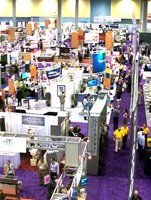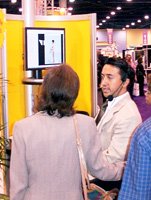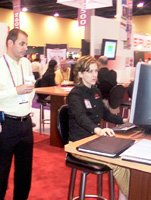Regional Sourcing, Technology Draw Interest at SPESA
MIAMI BEACH, Fla.—Fabric companies and apparel manufacturers that congregated at the Miami Beach Convention Center for the May 18–20 run of Material World, Technology Solutions and the SPESA Expo appeared to be warming up to the idea of a Western Hemisphere alliance that would compete in the world economy after 2005, when the World Trade Organization will lift quotas on apparel and textile imports for its members.
The show, which for the first time welcomed Raleigh, N.C.–based Sewn Products Equipment & Suppliers of the Americas members to show their machinery alongside fabrics and software, played to manufacturers and suppliers from Caribbean nations and Central and South America. Representatives from these regions, which stand to lose significant market share to China and other Asian countries when quotas are lifted on Jan. 1, 2005, worked to strike deals with their North American counterparts to compete with Asia. Mexico, which has already lost approximately 5 percent of its business to China, played a game of catch-up with other Latin and Central American producers.
“A lot of people were asking about CAFTA [Central American Free Trade Agreement] and whether it will go through by the end of the year. We don’t know,” said Mike Tyndall, senior director of marketing for Cary, N.C.–based Cotton Inc., which staged a pavilion representing 15 U.S.-based yard and fabric mills. “There’s a feeling that it will help the Western Hemisphere compete with Asia, but there are some who are not in favor of it.”
Those opposing the trade measure include labor groups, which argue that CAFTA would promote sweatshop labor and harm the environment.
U.S. Trade Representative Robert B. Zoellick has announced that President Bush will sign the CAFTA agreement on May 28. But the consensus among trade groups is that the agreement will not be presented to Congress until after the November general election.
At a SPESA seminar, New York–based sourcing expert Mary O’Rourke of the Jassin-O’Rourke Group LLC said there is strong interest in establishing regional sourcing strategies with Western Hemisphere producers to reduce fashion risks, markdowns and lead times. But the challenge will be finding the right partners because Western producers lag behind Asia in turning out fashion product.
Fred Isenberg, vice president of sales for Miami Lakes, Fla.–based New Generation Computing Inc. said the post-2005 economy will propel “super companies” such as Koramsa of Guatemala and the Argus Group of El Salvador to new levels at the expense of smaller companies. “Brands don’t want to own factories any more,” he said.
RFID, ERP and more
While sourcing issues will remain critical to manufacturers heading into 2005, exhibitors at SPESA and the Technology Solutions information technology show said they have never been busier because companies are looking to enhance speed to market and gain a competitive edge.
“Technology is continuing to drive our competitive advantage. That’s what Wal-Mart is saying,” said Mark Hansigner, director of marketing for Philadelphia-based printer systems company Avery Dennison Corp.
Avery enjoyed brisk business during the three-day event. The company showed its new radio frequency identification (RFID) printer, a piece of hardware that suppliers will become more familiar with as retailers continue to implement programs requiring the wireless technology to track inventory.
The pace of business appeared to validate the technology industry’s resurgence among its apparel industry clients.
“The feedback we received was that this was the best business they’ve seen in the past six, seven or eight years,” said Benton Gardner, executive vice president of SPESA. “People were doing business.”
CAD/CAM companies that had seen business slow in recent months witnessed revived interest in new computer-aided design software, which has been boosted by new advancements in 3-D technology.
“People were just walking into the booth and buying our software,” said Yoram Burg, chief executive officer of New York–based Optitex Inc., which markets Windowsbased CAD and 3-D software. Burg said customers showed interest in updating their systems.
Similarly, enterprise resource planning (ERP) vendors kept busy. “I think every seven years or so there’s this dash to rush to update your systems, and we’re seeing that now,” said Isenburg of NGC, which showed a new SQL server–based ERP system.
Alex Izmirlian, principal of Los Angeles–based DigiFab Systems, said speeding up production is the prime driver of new technology—even with printing equipment. The company debuted a new sublimation- printing system, which uses heat presses for polyester and poly-blend fabrics.
Daniel Moreau, executive vice president of Lectra SA, warned that while speed is important, there’s also an emphasis on maintaining quality and adding value. Lectra is working on improving mass customization with new product development software and made-tomeasure tools, as well as color management and design software. “People need to invest in design and creativity. That’s how they will survive,” Moreau said.
At the Gerber Technology Inc. booth, Gerber executives passed out free buttons with the statement “I’ve got the full package.” Gerber President James Arthurs said that is what it will take to compete in the new economy.
That message was one of many presented throughout the event.
SPESA will continue to host a machinery show every three years in the United States. Material World and Technology Solutions, which will hold their next events March 16–18 in Miami, will continue on an annual basis.
Talk of adding a new show
There’s been off-and-on talk of a second Material World show that would take place either in Las Vegas or Los Angeles, but Tim von Gal, executive vice president for show producer Urban Expositions, said the company has no imminent plans for such an event.
“We feel the West Coast is being serviced well right now, but we’re keeping our eyes open for opportunities,” he said.
























